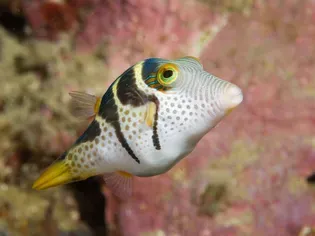All About Pufferfish Species
Updated on 04/26/24

Dive into the Extraordinary World of Pufferfish Species: A Comprehensive Guide
Pufferfish, often referred to as blowfish or balloonfish, are fascinating marine creatures that have captivated the curiosity of marine biologists and aquarists alike. With their unique ability to inflate their bodies with water or air, these fish present an intriguing spectacle that has earned them a place in the annals of marine wonders.
Unveiling the Pufferfish's Adaptive Arsenal
Pufferfish have evolved an extraordinary arsenal of adaptations that enable them to thrive in diverse marine environments. Their most iconic defense mechanism is their ability to rapidly inflate their bodies, transforming into spiny, balloon-like creatures that deter predators. The spines, formed from modified scales, provide a formidable barrier against attacks.
Exploring the Diversity of Pufferfish Species
The pufferfish family, Tetraodontidae, encompasses a wide array of species, each with its own distinct characteristics. From the diminutive Dwarf Puffer, measuring a mere 1 inch, to the colossal Giant Puffer, reaching lengths of up to 6 feet, pufferfish exhibit a remarkable range in size and appearance.
* Orbicular Puffer (Sphoeroides annulatus): Characterized by its spherical body and striking yellow and brown coloration, the Orbicular Puffer inhabits shallow waters in the Atlantic Ocean.
* Porcupine Puffer (Diodon hystrix): Known for its formidable spines, the Porcupine Puffer is a denizen of tropical and subtropical waters. When threatened, it erects its sharp, needle-like spines, creating a formidable defense against predators.
* Green Spotted Puffer (Tetraodon fluviatilis): This species is recognized by its vibrant, emerald-green coloration adorned with black spots. Native to the freshwater habitats of Southeast Asia, it is a popular aquarium species.
* Thornback Puffer (Gastrophysus spadiceus): Found in the Indo-Pacific region, the Thornback Puffer possesses a unique, triangular-shaped body that gives it a distinctive appearance.
* Spotted Boxfish (Ostracion meleagris): Not to be outdone, the Spotted Boxfish defies conventional pufferfish morphology with its cubed shape and intricate patterns resembling a mosaic.
Delving into the Pufferfish's Habitat and Diet
Pufferfish inhabit a diverse range of marine environments, from shallow coastal waters to deep-sea habitats. They are remarkably adaptable, thriving in tropical, subtropical, and temperate regions alike. Their diets primarily consist of invertebrates, such as crustaceans, mollusks, and echinoderms. Some species, like the Giant Puffer, are known to prey on small fish and invertebrates.
Unraveling the Pufferfish's Toxins and Culinary Controversies
One of the most intriguing aspects of pufferfish is their possession of tetrodotoxin, a potent neurotoxin that can be fatal if ingested. The toxin is concentrated in the fish's internal organs, especially the liver, gonads, and skin. Despite the potential dangers, pufferfish dishes are considered a delicacy in certain cultures, particularly in Japan, where trained chefs undergo rigorous training to prepare the fish without compromising its toxicity.
Pufferfish Aquarium Care: A Delicate Balance
For those captivated by the charm of pufferfish, keeping them in aquariums can be a rewarding experience. However, it requires specialized knowledge and utmost care. Maintaining optimal water conditions, providing adequate space for their territorial nature, and ensuring a suitable diet are crucial for their well-being. It is essential to consult with experienced aquarists and adhere to established guidelines to ensure the health and longevity of these fascinating creatures.
Conclusion: Embracing the Pufferfish's Enigmatic Nature
Pufferfish, with their remarkable adaptations, diverse species, and captivating behaviors, remain a subject of ongoing fascination for marine enthusiasts. Their ability to inflate their bodies, their intriguing defense mechanisms, and their unique role in the marine ecosystem contribute to their enigmatic nature. Whether observed in their natural habitats or admired in aquariums, pufferfish continue to captivate our imaginations, inviting us to unravel the secrets that lie within their extraordinary world.
Explore More Pets

Freshwater Aquarium Filters
How to Deal With Cloudy Aquarium Water

Saltwater Aquarium Filters
How Do You Remove Chloramines From Tap Water?

Freshwater Aquariums & Habitat
Can I Keep My Koi Fish Inside?

Saltwater Aquariums & Habitat
14 Best Floating Plants for Your Aquarium

Freshwater Fish Health
How to Treat Ich on Freshwater Fish

Saltwater Fish Health
Fin Rot in Aquarium Fish

Freshwater Aquarium Filters
How to Do Aquarium Water Changes

Saltwater Fish Health
How Do Fish Get Parasites?